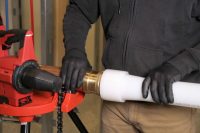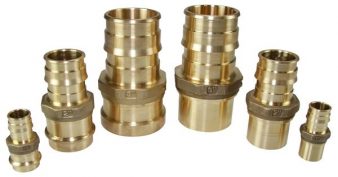By Laura Urbanek The Department of Energy is continuing its assault on the appliance energy efficiency standards program, with a proposed interpretive rule out this week that could freeze in place the standards for residential furnaces and commercial water heaters that use natural gas or propane. This shortsighted proposal could waste substantial amounts of fossil Read more
Industry Blogs

By Laura Urbanek
The Department of Energy is continuing its assault on the appliance energy efficiency standards program, with a proposed interpretive rule out this week that could freeze in place the standards for residential furnaces and commercial water heaters that use natural gas or propane. This shortsighted proposal could waste substantial amounts of fossil fuels and cost consumers billions in wasted energy costs. It’s a massive shift by DOE, which had already addressed this issue multiple times, as recently as 2016.
Fossil (aka “natural”) gas and propane are popular fuel sources for space heating and water heating in the United States, but when burned inside homes and businesses they emit climate-altering pollution and can impact indoor air quality. About half of homes are heated with fossil gas, and most of those homes used a gas furnace. Space heating represents the largest energy expense for the average U.S. household, accounting for about 45% of energy bills.
Standards for residential natural gas furnaces were last meaningfully updated in 1992, which means that many homeowners are already wasting climate-harming fossil fuels when they heat their homes. More efficient standards for furnaces, alone, could cumulatively save consumers $24 billion on their utility bills by 2050, while reducing harmful carbon pollution by nearly 85 million metric tons (equivalent to the annual emissions from 22 coal-fired power plants). But with this proposal, these savings are all but guaranteed to be lost, as DOE yet again prioritizes industry interests over the health and well-being of consumers and the planet.
Last fall, groups representing the gas industry—American Public Gas Association (APGA), Spire, Inc., the Natural Gas Supply Association (NGSA), the American Gas Association (AGA), and the National Propane Gas Association (NPGA)—petitioned DOE to change how it interprets the definition of “performance characteristics” as it relates to gas furnaces and commercial water heaters. While this gets wonky pretty quickly, the issue boils down to the use of condensing or non-condensing technology.
Condensing vs. Non-Condensing
Furnaces or water heaters using condensing technology capture additional heat from the flue gases that would otherwise be lost up the chimney, and return usable heat. This results in a more efficient furnace or water heater with significant energy savings for consumers. In fact, without the use of condensing technology, there is little room for energy efficiency improvements over existing models of gas equipment.
The energy-saving benefits of condensing technology are immense. A recent report from the Appliance Standards Awareness Project found that condensing technology can reduce residential gas water heater energy consumption by about 25 percent. DOE estimated in a September 2016 furnace supplemental proposed rule that consumers would save about $700 on average by purchasing a furnace that complies with the proposed standard, after accounting for all costs (including any relevant venting and plumbing costs related to installation).
DOE Changes its Tune
Condensing equipment requires different venting compared to non-condensing equipment, and also requires a plumbing connection to dispose of the condensate produced. The gas industry groups argued that the presence of this different venting and a plumbing connection are “features” or “performance characteristics” that require these products to be put in a separate product class, with separate standards for condensing and non-condensing products. That’s a problem, because it means that inefficient furnaces and water heaters that waste energy by not utilizing up-to-date technology will still be available on the market—which defeats the purpose of a higher energy-saving standard that benefits all consumers.
We do not agree with the gas industry groups’ interpretation of what constitutes a “performance characteristic,” as we laid out in comments submitted to DOE on the petition back in March, In fact, we find what the gas industry groups requested to be contrary to the law.
What’s more: DOE itself previously disagreed with this interpretation! The gas industry groups have been looking for a way out of updating the standard for years, and each time, DOE has given a consistent, rational explanation for its decision to not treat condensing products as a unique product feature. Most recently, DOE cautioned in the March 2015 residential furnace notice of proposed rulemaking (NOPR), and reconfirmed in its September 2016 supplemental NOPR, “Tying the concept of ’feature‘ to a specific technology would effectively lock-in the current existing technology as the ceiling for product efficiency and eliminate DOE’s ability to address technological advances that could yield significant consumer benefits in the form of lower energy costs while providing the same functionality for the consumer.” Yet this is exactly what the gas industry groups asked DOE to do in the petition at hand, without providing a compelling reason for why DOE should reverse its long-held, consistent determination of product classes.
Unfortunately, DOE has done a 180-degree turn to change its position, now agreeing with the gas industries—to the detriment of consumer energy savings. DOE claims that they’re looking out for the consumer, citing concerns about how exterior venting could impact the aesthetics of a home, and that requiring better technology would result in financial hardship to low-income consumers. Yet, groups like the National Consumer Law Center and the Consumer Federation of America—whose job day in and day out is to represent interests of low-income consumers—are strongly opposed to DOE’s approach. They note that consumers—especially low-income consumers—will suffer “substantial financial harm,” losing out on billions of dollars in energy savings under the proposal at hand.
There are more steps DOE needs to take before this is a done deal, and we’ll be fighting at every step of the way. Changing the rules to stymie progress is not in the best interest of consumers, especially low-income consumers who spend a disproportionate amount of their income on energy bills. This proposal rests on shaky legal ground, and even worse, it wastes fossil fuels. And when fossil fuels are responsible for so much of the climate crisis, a proposal to increase waste is simply unconscionable.
 Laura Urbanek is Senior Energy Policy Advocate, Climate & Clean Energy Program, NRDC.
Laura Urbanek is Senior Energy Policy Advocate, Climate & Clean Energy Program, NRDC.

Two piping systems that are taking the domestic-water and hydronic heating and cooling landscape to a new level. These innovative solutions are providing the construction industry with systems that are easier to learn (to help with the skilled-labor shortage), faster to install (to meet tight construction schedules) and provide cleaner installation sites (for jobsite safety) Read more
Two piping systems that are taking the domestic-water and hydronic heating and cooling landscape to a new level. These innovative solutions are providing the construction industry with systems that are easier to learn (to help with the skilled-labor shortage), faster to install (to meet tight construction schedules) and provide cleaner installation sites (for jobsite safety).
 For PEX pipe, popularity is growing for risers, distribution piping and even direct-burial applications in sizes 3″ and down. Its flexibility, fast installations and stable pricing make it appealing for contractors, and its corrosion resistance and durability in freezing conditions make it highly attractive to building owners.
For PEX pipe, popularity is growing for risers, distribution piping and even direct-burial applications in sizes 3″ and down. Its flexibility, fast installations and stable pricing make it appealing for contractors, and its corrosion resistance and durability in freezing conditions make it highly attractive to building owners.
For copper press, contractors are enjoying a safer, flameless connection system that eliminates solder, heat and flux from the job site while offering contractors a metallic system that is faster and easier to learn and quicker to install.
Now, imagine combining the best of both worlds — PEX expansion and copper press — for quicker, easier training, faster installs and safer jobsites to get the job done right in less time.
 With the launch of the industry’s first ProPEX® expansion to copper press transitions, professionals now have a solution for a completely flameless piping system that eliminates the hassles, costs and hazards of soldering while also providing more efficient installs.
With the launch of the industry’s first ProPEX® expansion to copper press transitions, professionals now have a solution for a completely flameless piping system that eliminates the hassles, costs and hazards of soldering while also providing more efficient installs.
Watch how easy it is to make these transitions.
Manufactured from high-quality, lead-free brass to meet all local and national domestic-water building codes, the transitions are available in both male and female configurations with the female adapters featuring an EPDM rubber O-ring for a dependable seal.
Best of all, they feature a patented design for securely fastening the pipe and fitting together, eliminating the need for a stainless-steel ring commonly used in large-dimension copper press fittings.
Compared to soldering copper, these transitions reduce an overall project timeline by an average of 71%, helping to manage a project’s schedule and, ultimately, the bottom line. And because they are backed by a 25-year transferable limited warranty, the transitions offer additional confidence and peace of mind.
So if you’re like most construction professionals out there, feeling the crunch of the labor shortage but still want the quality of a professional piping system, look to a hybrid PEX expansion and copper press system. The end result can be money in the bank.
To learn more about the transitions, visit uponorpro.com/copperpress_us.

Kim Bliss is the content development manager at Uponor. She can be reached at kim.bliss@uponor.com.

Rinnai supports skilled trade gap by partnering with Folds of Honor The skilled trade industry is in desperate need of enthusiastic workers as the baby boomers are retiring. However, vocational school has become an obsolete term for high school students, the exact age employers are targeting the most.Skilled Trade Gap Baby boomers are beginning to Read more
Rinnai supports skilled trade gap by partnering with Folds of Honor
The skilled trade industry is in desperate need of enthusiastic workers as the baby boomers are retiring. However, vocational school has become an obsolete term for high school students, the exact age employers are targeting the most. Skilled Trade Gap
Skilled Trade Gap
Baby boomers are beginning to retire and recruiters are looking for new skilled trade workers to fill their shoes. What is the problem? There are not enough laborers equipped to fill them. With a push toward a four-year college degree, many generational skilled trade workers are leaving the family business, and only a few men and women are choosing trade career options.
Vocational school is soon left out of the conversation when teenagers are told that going to a four-year institution would provide them with a more reliable and better paying career. Even though vocational school is less expensive, provides students with a valuable skill, and most students are hired immediately into the workforce upon completion. Knowing these statistics, teenagers made the decision to go to college which created a large gap between themselves and the current baby boomers in the industry.
There are 31 million skilled trade positions needing to be filled, according to Adecco US. It is important to reopen the conversation and benefits of vocational school with high school students as well as introduce them to these ideas as soon as the word “college” is mentioned.
How Can We Help?
Rinnai is dedicated to helping close the skilled trade gap by encouraging more students to seek a vocational education. By partnering with Folds of Honor, a nonprofit organization started by Major Dan Rooney, Rinnai will be providing trade-specific educational scholarships to spouses and children of America’s fallen and disabled service members. For every Rinnai tankless water heater or boiler sold this year, Rinnai will make a contribution up to $250,000 to fund scholarships in the plumbing and HVAC trades. We hope our contribution will help to strengthen our industry for the current generation to provide skills for the future.
We encourage you to join Rinnai by honoring our service members’ sacrifice and educating their legacy, by donating to Folds of Honor, by visiting https://www.rinnai.us/FoldsOfHonor.

Does propylene glycol protect a system? Firstly, before adding any propylene glycol to a system, you should understand the design life of it. Often, the less expensive propylene glycol holds a shorter design life of 3–5 years, whereas the premium propylene glycol holds a design life of roughly up to 15 years. As propylene glycol Read more
Does propylene glycol protect a system?
Firstly, before adding any propylene glycol to a system, you should understand the design life of it. Often, the less expensive propylene glycol holds a shorter design life of 3–5 years, whereas the premium propylene glycol holds a design life of roughly up to 15 years.

As propylene glycol begins to degrade, it becomes acidic, which as you can imagine has a major impact on key components within the system—attacking metal surfaces such as iron pipework, pumps and heat exchangers, which is why the design life of glycol needs to be seriously considered. A premium glycol contains a higher quality inhibitor which acts as a buffer to keep the system’s water pH idyllic, but the system should be checked on a regular basis anyway—the ideal level is 8 – 8.5. Once system pH goes below 6.5, inhibitor with buffering agents will need to be added to elevate the pH levels.
How much glycol should I add to the system?
Boiler manufacturers often advise that glycol should make up no more than 50% of the system’s volume, with some HE boiler applications being reduced to 35%.
Can system efficiency be affected if too much glycol is added?
Yes, glycol has a higher viscosity than water—too much of it can reduce the effectiveness of water flowing through pipework, and too much glycol can also reduce heat transfer capabilities. Both of these aspects together can have a serious impact on heating components such as pumps and heat exchangers, causing them to work harder to maintain system temperature and flow, so much so that it can lead to over-heating and eventually, failure. This is why many boiler manufacturers have warning limitations on the amount of glycol used, because too much can damage components and even result in boiler breakdowns.
Do I need a cleaner and dirt filter if the system has already got pre-mix glycol?
Yes. Pre-mix glycol is not designed to lift and capture magnetite—it’s designed to prevent system water from freezing during cold winter months, and the inhibitors in glycol are used as a buffer to prevent acidity levels from rising.

Magnetite, also known as black iron oxide sludge is formed as a result of air oxidizing inside an untreated system. Unfortunately, a pre-mix glycol does not mean that a system has been sufficiently treated, and here’s why:
 A cleaner contains surfactants and dispersants that surround the magnetic particles, bonding them until they become dislodged from surfaces such as metal pipework. Of course, the longer a cleaner is left in the system, the more time it has to bond and dislodge debris, but you should always check the label for time-frames because cleaners can also become acidic when left in a system for too long
A cleaner contains surfactants and dispersants that surround the magnetic particles, bonding them until they become dislodged from surfaces such as metal pipework. Of course, the longer a cleaner is left in the system, the more time it has to bond and dislodge debris, but you should always check the label for time-frames because cleaners can also become acidic when left in a system for too long- A system flush allows the dislodged particles and cleaner to be removed from the system, but this is not where treatment should stop
- A magnetic dirt filter provides long-term protection. Just because the system has been cleaned and flushed once, doesn’t mean that magnetite isn’t going to return. The filter continuously collects magnetic dirt particles, preventing them from circulating through vital narrow waterways and blocking valuable system components such as pumps and heat exchangers
- An inhibitor forms a protective layer on surfaces such as pipework, but this is not the only benefit of an inhibitor. Some inhibitors are specifically designed to counteract residue cleaner left in the system, even after flushing, ensuring that the system water remains pH neutral
- Finally, testing and maintenance ensures that elements such as chloride, copper, iron, water hardness and pH are not affecting the longevity and efficiency of the heating system. These checks should be carried out on an annual basis for residential systems, and more frequently for commercial/industrial systems.
 Andrew Lapinsky, Senior Sales Manager and Water Treatment Specialist, ADEY.
Andrew Lapinsky, Senior Sales Manager and Water Treatment Specialist, ADEY.

Forced air is still the traditional method of heating homes, but radiant heat is gaining significant momentum as an alternative. According to HGTV, the growth rate of in-floor radiant heating systems was estimated at 30 to 50 percent per year. At the heart of this shift is not just one single benefit. It’s a variety of advantages Read more
Forced air is still the traditional method of heating homes, but radiant heat is gaining significant momentum as an alternative. According to HGTV, the growth rate of in-floor radiant heating systems was estimated at 30 to 50 percent per year.
At the heart of this shift is not just one single benefit. It’s a variety of advantages that radiant floor heating systems bring to the table, the combination of which enhance the daily lives of a home’s occupants:
Even Heat Distribution
When a house is heated by a forced-air system, it will always be warmest near the vents that distribute the air. This can lead to “hotspots” on one end of a room while the other side of the room remains cool. And because hot air rises, upstairs rooms will be warmer than those downstairs.
With radiant floor heating systems, homeowners control how heat circulates in their home. Rather than heating the surrounding air, the heat that radiates from the floor warms other objects in the room and is evenly distributed without the potential for heat loss.
Improved Air Quality
While air pollution is more often associated with the outdoors, indoor air can be dirty as well. Whether it’s dust, pet dander or chemicals from fragrances (among other sources) that pollute the air, forced-air systems exacerbate the problem for allergy sufferers. That’s because the forced, heated air will stir up and mix with these airborne particles.
Since radiant floor heating systems don’t move air to deliver heat, the circulation of indoor particles is minimized. With less pollutants blown around, indoor air quality improves, which benefits allergy sufferers.
No Ductwork
The ductwork in forced-air systems further contributes to air pollution. When it’s riddled with cracks and holes, more dust and odors can enter and circulate. Without proper insulation, these same cracks and holes can cause air to leak out of the system and hinder its overall efficiency.
With no ducts, radiant floor heating systems reduce the churn of dust and allergens while curtailing heat loss. The absence of ducts means less work for homeowners as it eliminates the need for repairs like cleaning out ducts clogged with particles or adding insulation when heat loss mounts.
Energy Savings
With their uneven distribution of heat and potential for heat loss, traditional heating systems can be energy hogs.
Depending on how well a house is insulated, radiant floor systems can save up to 30 percent compared to forced-air systems. In terms of bills, the impact is quite significant as space heating is the largest energy expense for the average U.S. home, accounting for around 45 percent of energy bills.
Noiseless Operation
Homes should be quiet, but forced-air systems can be noisy as furnaces cycle on and off, gaps in the ductwork whistle and loose parts rattle.
By comparison, radiant floor heating systems are exceptionally quiet.
As consumers learn more about the advantages of radiant heating, its popularity will continue to grow.
 Josh Quint is product manager, heating and cooling, for Viega LLC.
Josh Quint is product manager, heating and cooling, for Viega LLC.
